7 things to know about smog
From history to its effects, here are some interesting facts about smog

The view of downtown Los Angeles skyline is obscured by smoke, ash and smog as seen from the Griffith Observatory Monday, Sept. 14, 2020 in Los Angeles.
(Allen J. Schaben / Los Angeles Times via Getty Images)
When you hear the word "smog", your mind might jump to images of haze-obscured skylines and cars pumping out exhaust.
Here are seven things you should know about the term.
1. The word was coined about 1950
According to the Environmental Protection Agency, the word "smog" was first used about 1950 to describe a mixture of smoke and fog in London. Now, the word is used to describe a mixture of air pollutants made up of mainly ground-level ozone.
2. It’s made up of mostly ozone
Smog is made up of mainly ozone, which is a colorless toxic gas that occurs naturally in Earth’s atmosphere. When it is found in the upper atmosphere, between 10 and 30 miles above us, the gas is harmless and helps form a protective layer that protects us from the sun’s ultraviolet rays. However, when ozone is found near ground level, it can cause problems for people who breathe it.
3. It’s not just a summer thing
Most people tend to think that smog is just something that gets worse during the hot, sunny days of summer, but it can happen any time of the year if weather conditions allow it. During the warmer months, most of the smog is derived from chemicals in car and factory exhaust reacting with sunlight. During the colder months, a type of weather pattern called an inversion becomes more common and can trap pollutants close to the ground. In fact, some people categorize smog by the season (e.g. summer smog and winter smog).
4. Your runny nose might be caused by it
Air pollution can cause all kinds of problems for life on Earth. During a particularly smoggy day, a person may experience symptoms like a runny nose, watery eyes, a cough and a scratchy throat. People with asthma may experience increased breathing problems during days with lots of smog.
5. It can stunt plant growth
According to the government of Alberta, Canada, ground-level ozone can slow down the growth of plants. This can lead to lower crop yields and reduce a plant’s ability to fight off disease and pests.
6. It turns the sky brown or gray
When smog levels are high, the sky can take on an almost smoky quality. Depending on how the particles of pollution in the air interact with sunlight, the sky can appear to have a brownish or grayish color.
7. You can help reduce it
Smog is entirely manmade, so there are ways that we can help reduce it. That starts by knowing and understanding the Air Quality Index, which tracks both ozone and particle pollution. Whenever the AQI is high, officials will usually issue an air quality alert and ask people to reduce their time outdoors. Driving less and putting off outdoor burns can also help reduce air pollution levels.